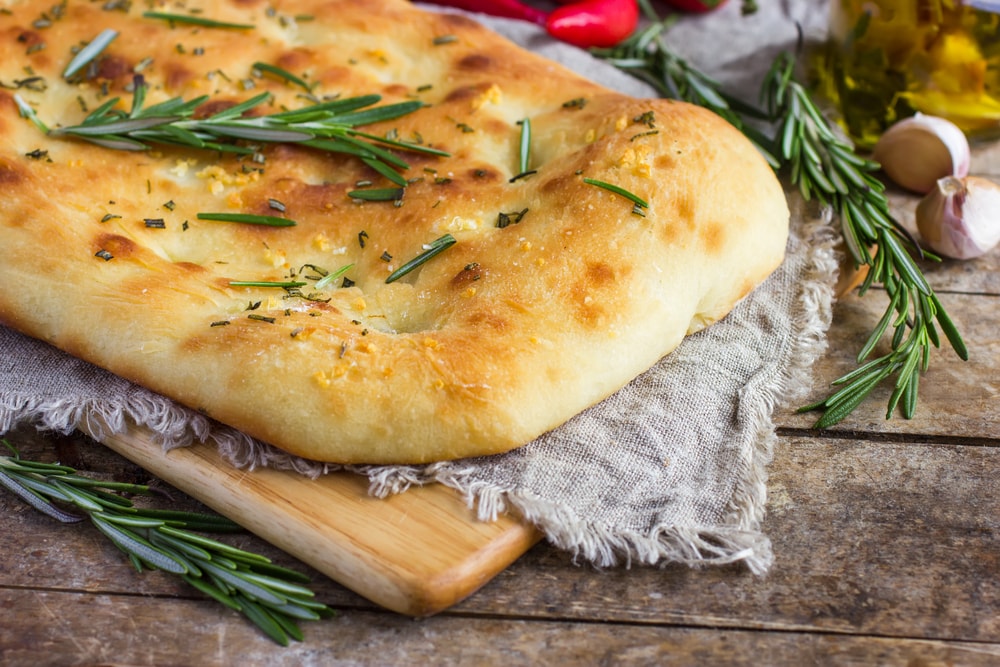Book A Table: 0207 132 1212
Monday to Friday: Lunch 12 to 3pm
Dinner 5.00pm to 11pm
Saturday and Sunday: 12pm to 11pm
Book A Table: 0207 132 1212
Monday to Friday: Lunch 12 to 3pm
Dinner 5.00pm to 11pm
Saturday and Sunday: 12pm to 11pm

It’s a little known fact that over 350 types of bread, originate from across Italy. Bread is a staple of the Italian lifestyle, with most restaurants featuring their own take, using breads like Focaccia and Ciabatta. From thick loaves, and pizza bases, to flatbreads and the humble breadstick. Tuck into five of the best as chosen by Bella Cosa.
Out of all the famous breads of Italy, the Focaccia is one of the most loved. Often packed the flavour and seasoning, the Focaccia takes its name from the Latin word for ‘hearth’. The bread is mottled with dips when properly baked, with the original Roman process ensuring it was cooked in the embers of a hearth.
There isn’t much that goes into this popular bread, with strong flour, olive oil and yeast, the keys to achieving the recognisable surface and texture. If you bake this at home, ensure you roll out the bread fairly thickly, then dent the surface to prevent any bubbles during the bake. Finally, focaccia is coated in olive oil, as well as a variety of versatile toppings, such as herbs, garlic and onion.
It’s fairly common for individual regions to put their own stamp on Focaccia. In the town of Recco, they combine the dough with Stracchino cheese before the bread is baked. If you have a sweet tooth, the ultimate combination of sweet and savoury is the focaccia dolce, made with honey, sugar or fruit.

The Ciabatta, is another common type of Italian bread, easy to find on the shelves of your nearest supermarket. The name Ciabatta literally translates into English as ‘slipper’ with the fairly flat shape, looking similar to the cosy type of footwear.
Although its origins are unclear, the unique porous centre and crispy crust, make the perfect partner to Italian classics and dishes with a lot of sauce. and this flat white bread with a porous centre is so named because of its slightly slipper-like shape. Unlike the Roman Focaccia, some stories suggest this bread was created in the 1980s!
This Italian sourdough, originated with a royal background. In the 16th century, the twisted bread, partially resembling a croissant, was presented to the Duke of Ferrara. It takes a steady hand and patience to ensure the dough is moulded into the correct shape. In 2004, the bread was even given protected status, ensuring that only bread made in the correct region, could be classed as Coppia Ferrarese. As we’ve come learn with Italy, bakers like to experiment. There are a number of variations of Coppia Ferrarese across Ferrara, from changes baking practice to the naming of different parts of the bread.
With over 350 bread types, we had to include a famous flatbread! The Piadina is a very thin type of flatbread, making it ideal for filling or as a wrap. Traditionally, the Piadina was made using a heated terracotta plate but is now more commonly made on metal hot plates. Originally hailing from Romagna, the bread was held as a valuable staple for the poorest in the area. Now, you can find piadinas in special piadina kiosks, where it’s is filled with meat or cheese.
The Grissino breadstick, comes with a very interesting backstory. Originally, this type of crispy bread, was first baked in the city of Turin during the 17th century, for a duke who had been made ill from eating germ-ridden bread.
From then on, the success of this small but mighty type of Italian bread was always on the up. Among the many admirers of the breadstick from Turin, was the great French figure of Napoleon Bonaparte. The French general created a courier service from Turin to Paris, to satisfy his love for what he called, ‘les petits bâtons de Turin’
Due to its shape and length, the Grissino can easily be seasoned with oregano or cumin plus can be used to mop up leftover sauce from a meal!
We’re a huge fan of classic Italian dishes and creations at Bella Cosa. Our new Spring menu takes the freshest of ingredients to create well-known dishes and introduces new creations for you to enjoy. Book a table to experience true Italian cuisine.
We care what our customers think of us and so should you. We are partners in your business and your success is ours in your business.